How to Fix Mac Error Code -50
The operation can't be completed because an unexpected error occured (-50)
Some Mac users are encountering the Mac Error Code -50 when they attempt to copy or move some files on their Mac computer. In most cases, this issue occurs with files stored on an external drive / HDD.

As it turns out, there are several different scenarios that might contribute to the apparition of this issue:
- A temporary file is stuck in a limbo state – The most common culprit that will end up causing this issue is a glitched temporary file that’s dependent on the file system. In this case, a simple reboot should clear the temp folder which will also end up resolving this issue.
- OS Firmware glitch – In case you’re dealing with a persistent temp file glitch, it’s likely that you will not be able to fix the issue conventionally. In this case, the ideal approach is to go for a power cycle procedure (this will drain the power capacitors and clear any type of temporary data).
- Bad File metadata – It’s also possible that the error occurs due to name & file type metadata that conflicts with the values that the Finder app expects. In this case, you can clear the problematic metadata by renaming the file and changing the extension manually before moving the file.
- Corrupted NVRAM and PRAM data – As it turns out, the issue can also be rooted in one of these two special memory types that your MAC computer maintains. If this scenario is applicable, you should be able to fix the issue by resetting these 2 memory types.
- Corrupted drive files – Under certain circumstances, you might encounter this problem due to a corruption issue that affects the drive that is currently holding the file you are trying to move or copy. In this case, you should run the First Aid feature of Disk utility in order to resolve the issue.
- Flash drive is of wrong file type – In case you’re encountering this issue when attempting to copy some files on your external drive, it’s likely that it’s formatted to NTFS (which OS X doesn’t like). If this scenario is applicable, you should be able to fix the issue by formatting the drive to FAT 32.
Rebooting your Mac computer
Before trying any of the more advanced fixes that we featured below, you should start with a simple reboot. In case the Mac Error Code -50 is caused by a file that’s stuck in a limbo state, rebooting your machine will clear the temporary memory which will also end up fixing this issue.
To reboot your Mac computer, you can simply press the power button and select the Restart button once the prompt appears.
Additionally, you can click on the Apple icon (top-left corner) and click on Restart from the newly appeared context menu.
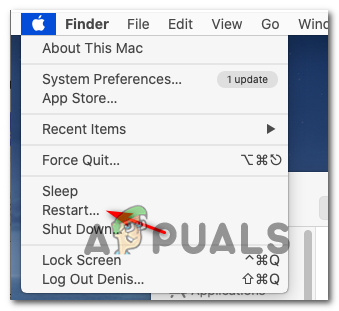
Note: If you’re a shortcut kind of guy, you can force a restart by pressing Control + Command + Eject/Power button.
After you restart, wait for the next startup to complete and see if the issue is resolved once your Mac computer boots back up.
In case you still have the same problem, move down to the next potential fix below.
Performing a Power Cycle Procedure
If a reboot didn’t do the trick for you, it’s very likely that you’re dealing with some type of persisting temp file that will not get removed conventionally.
If this scenario is applicable, your best chance at fixing the issue is to force a power-cycling procedure – This operation will force the OS to do a complete temp file sweep, resolving the vast majority of temp-related issues.
Several affected users have confirmed that this operation was the only thing that allowed them to resolve the Mac Error Code -50 and copy files from and on external drive files.
To perform a power cycle on your Mac computer, follow the instructions below:
- Before you do anything else, start by removing any external disk or flash drives that is currently connected to your MAC computer. If you have any DVD/CD in the optical drive, take it out.
- Once you’ve ensured that no external devices or media are connected to your MAC, click the Apple icon (top-left corner) and click on Shut Down from the newly appeared context menu.
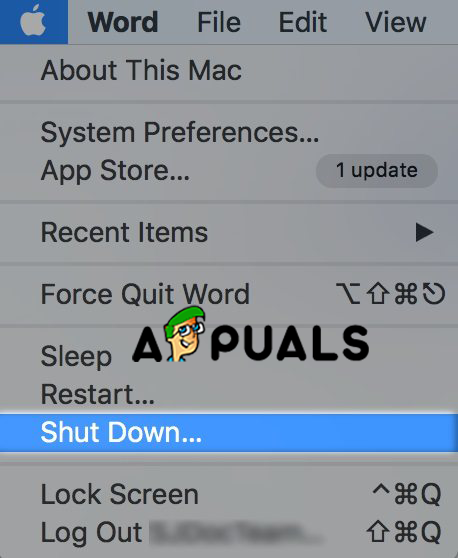
Shut Down Mac - Wait until the procedure completes and wait until your MAC no longer shows any signs of life. Next, go ahead and physically disconnect the power cable from the power outlet and wait for 30 seconds before connecting the power outlet again.
Note: This operation is done in order to drain the power capacitors and ensure that there are no temp files that might still cause this issue. - Start your computer and wait for the next startup to complete.
- Repeat the action that was previously causing the problem and see if the issue is now resolved.
In case you’re still seeing the Mac Error Code -50, move down to the next potential fix below.
Renaming the File
As it turns out, in some cases, the Mac Error Code -50 is actually caused by a name or extension issue (most likely facilitated by a registry value that conflicts with the data shown by the Finder app.
Some users that were facing the same issue have confirmed that they were able to fix the issue by renaming the file, changing the extension of the file, and then moving it. In case the moving part is successful, you can simply rename the file again, set the original extension and the problem is fixed.
This fix is effective in those situations where the metadata of the file is actually responsible for this particular issue.
To rename a file and change its extension in order to move it, follow the instructions below:
- Click on the Finder app (bottom-left corner) and navigate to the location that stores the file that is ultimately showing the Mac Error Code -50.
- Once you get to that location, right-click on it and choose Rename from the newly appeared context menu.
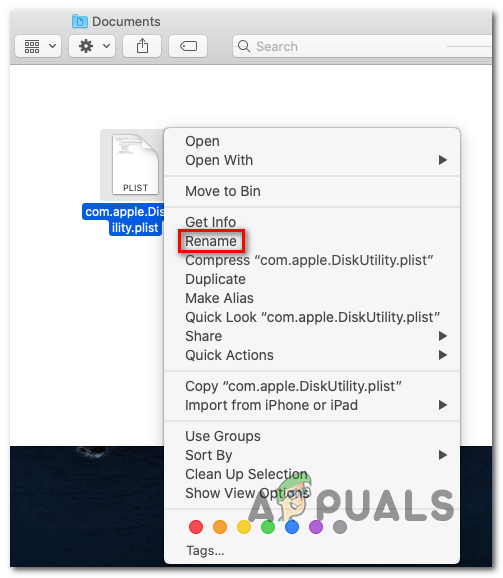
Renaming the problematic file - Once the name becomes editable, rename it however you want but don’t forget to also change the extension to a different file type (the safest bet is .txt)
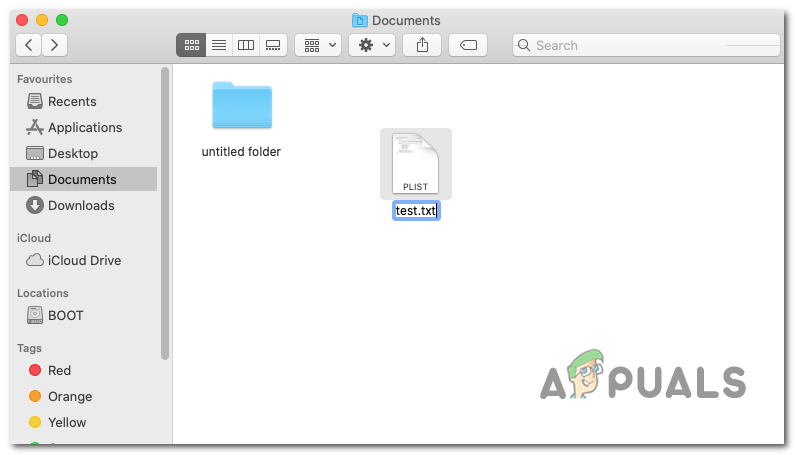
Renaming the file + Extension Note: You will be asked to confirm the extension change. When this happens, click on Use .text to migrate to the new extension type.
- Once the file has been renamed successfully, move the file to the new location and see if you are able to do so without getting the same error message.
- After the file is successfully moved to the new location, rename it to the old name and change the extension back to the original one.
In case this method is not applicable to your particular scenario, move down to the next potential fix below.
Resetting NVRAM and PRAM
If the operations above didn’t allow you to fix the Mac Error Code -50, the issue in your case is most likely rooted in NVRAM (Non-Volatile Random-Access Memory) or PRAM (Parameter RAM).
Your MAC uses NVRAM to store certain settings and access them quickly while PRAM is used to store mostly Kernel Information. However, similar to regular RAM, both PRAM and NVRAM are prone to storing information that might cause an issue with some core components of your MAC.
If this scenario applies to you, you should be able to fix the issue by resetting both the PRAM and the NVRAM. If you don’t know how to do this, follow the instructions below:
- Start by shutting down your MAC completely (regular shut down, not hibernation).
- As soon as you turn it ON, immediately press and hold the following keys:
Option + Command + P + R
- Keep all four keys pressed for over 20 seconds. During this procedure, your MAC will make it look like it’s restarting, but don’t let go of the four keys yet.

Forcing an NVRAM and PRAM reset - Be on the lookout for the startup sounds – As soon as you hear the second one, release all four keys at once.
Note: If you have a model with T2 Security chip implementation, release the 4 keys AFTER the Apple logo disappears for the second time. - Once the next startup is complete, attempt to copy or move a file and see if the Mac Error Code -50 has been fixed.
In case you’re still encountering the same problem, move down to the next potential fix below.
Running First Aid in Disk Utility
In case you are encountering this problem when trying to copy media on or from an external space like an external HDD or flash disk, you might be dealing with corrupted files that are preventing this operation from completing.
Some user that was facing the same problem has confirmed that they were able to resolve this issue by running the First Aid feature of Disk Utility on both the external drive and the OS drive.
To run the First Aid feature of Disk Utility, follow the instructions below:
- Click on the Finder App located in the Action bar at the bottom of the screen.
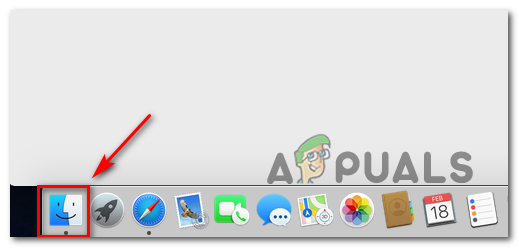
Opening the Finding App - Once you’re inside the Finder app, click on the Go button (located in the ribbon bar at the top) and click on Utilities from the context menu.
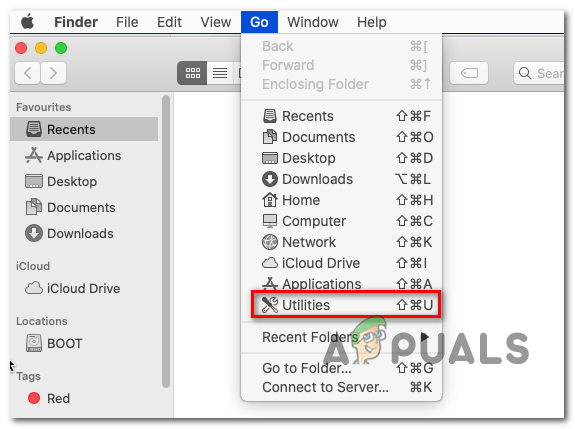
Accessing the Utilities menu - Once you’re inside the Utilities section, simply click on Disk Utility from the list of available options.
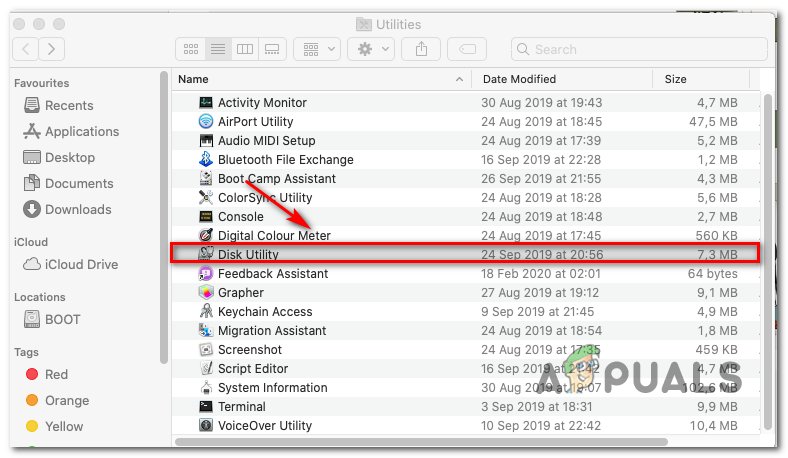
Opening the Disk Utility on Mac - Inside the Disk Utility screen, start by clicking on Boot drive (left-hand section of the screen), then click on First Aid Icon (at the top of the screen).
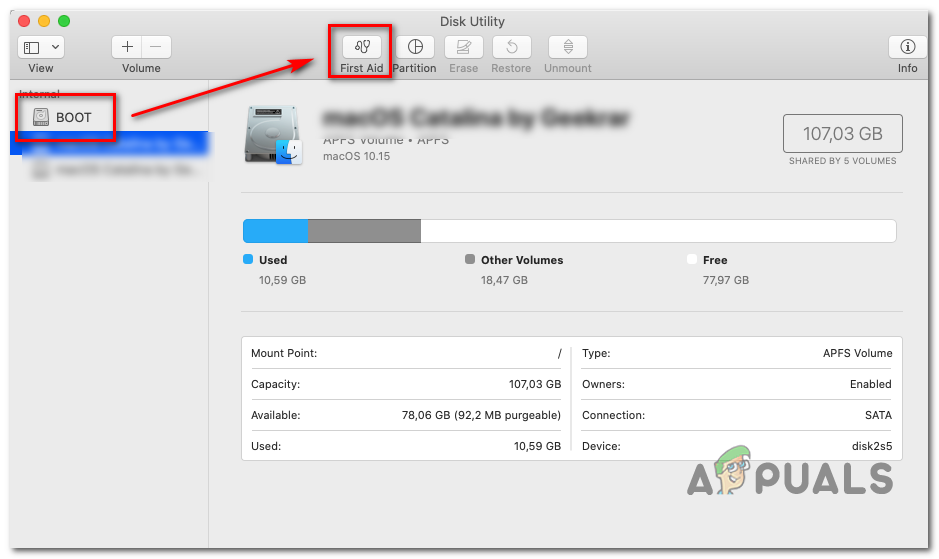
Running the First Aid utility on Boot drive - At the confirmation prompt, click on Run to start the process. After you do this, the utility will start checking the entire volume for errors, then it will repair the problematic files if any instances are found.

Running First Aid on Boot Note: If no errors are found, you will get a success message with a green tick.
- Once the operation is complete, repeat steps 4 to 6 with the external drive that you’re having trouble copying files from/to.
- After you’ve successfully run First Aid on every affected drive, restart your Macintosh and see if the problem is fixed at the next system startup.
In case the same problem is still occurring, move down to the next method below
Formatting drive to FAT 32
Another fairly common culprit that might facilitate the apparition of the Mac Error Code -50 is an incompatible file type used for the portable storage device used when trying to copy or move data. In most reported cases, this problem will occur due to the fact that the flash drive / HDD / SSD is formated to NTFS.
Since OS X will not work with NTFS, you’ll need to format the external drive to FAT 32. A lot of affected users have confirmed that this operation was the only thing that resolved this issue.
IMPORTANT: Disk formatting will end up deleting any information stored on that drive. If you don’t want to lose that data, connect it to a different device, and create a backup before initiating this procedure.
When you are prepared to change the format type of your external drive to FAT 32, follow the instructions below:
- Click on the Launchpad (from the bottom of the screen) and search for ‘disk’, then click on Disk Utility from the list of results.

Opening Disk Utility - Once you’re inside the Disk Utility tool, click on Partition from the ribbon bar at the top, then click on the partition you want to format (under Volume Information) and click Format (under Volume Information).
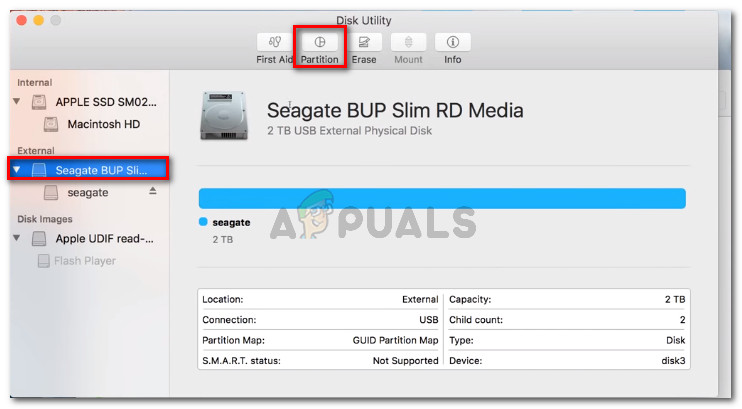
Re-formatting the external drive with Disk Utility - Set the File format to MS-DOS (FAT) and, ensure that the appropriate partition is selected and hit Apply.
- Wait until the process is finished, then restart your computer and see if you are able to copy files on it without encountering the Mac Error Code -50.





